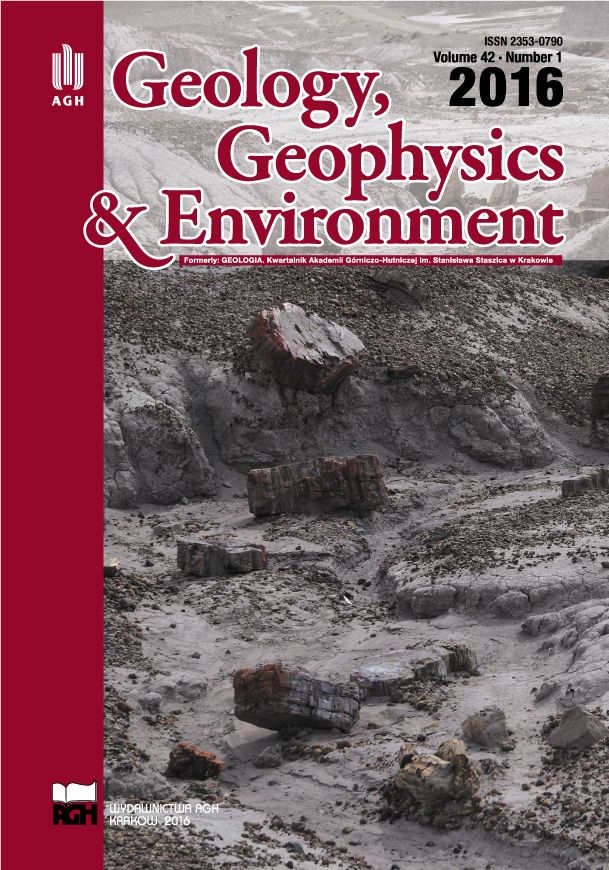The effect of Ca-Pb and P-As substitutions on the solubility of hydroxylapatites
DOI:
https://doi.org/10.7494/geol.2016.42.1.100Keywords:
hydroxylapatite, isomorphic series, solubility, calcium, lead, johnbaumite, hydroxypyromorphite, hydroxymimetiteAbstract
Hydroxylapatites are important biomaterials. Substitutions of Pb for Ca and As for P in hydroxylapatites are recently intensively studied due to their significance in the environmental immobilization of Pb and As (Lee et al. 2009; Chlebowska et al. 2015; Motyka et al. 2015) The general chemical formula of minerals in the apatite group is expressed by A5(XO4)3Z, where A are bivalent cations (e.g., Ca2+ or Pb2+, cations are distributed on two distinct crystallographic sites), XO4 is a trivalent oxyanion (e.g., PO43-, AsO43-), and Z is a monovalent anion (OH, F, Cl, or O). Positions Z and X may be partly filled with carbonate CO32-. The structure of hydroxylapatite allows for unlimited substitutions of Pb2+ for Ca2+ and AsO43- for PO43-.
The ability of lead and arsenic apatites to immobilize these toxic elements result from their high durability and low solubility at the conditions on the Earth surface. Various apatites possess different thermodynamic properties including different solubility in aqueous solutions but the systematic variation of these properties in solid solution series is poorly undertsood.
The main objective of this research is determination of systematic variation in the solubilities of hydroxylapatites resulting from cationic substitutions of Pb2+ for Ca2+ and anionic substitutions of AsO43- for PO43- in their structure. Three solid solution series were synthesized:
HPY hydroxypyromorphite Pb5(PO4)3OH – HAP hydroxyapatite Ca5(PO4)3OH
HMi hydroxymimetite Pb5(AsO4)3OH – JBM johnbaumite Ca5(AsO4)3OH
HAP hydroxyapatite Ca5(PO4)3OH – JBM johnbaumite Ca5(AsO4)3OH
The phases were synthesized from aqueous solutions at high pH above 8, at ambient temperature, by dropwise mixing of chemical reagents. The products are white, fine, homogeneous crystalline powders. Chemical composition determined by SEM/EDS is close to theoretical. X-ray diffraction confirms their crystalline structure and systematic changes in unit cell parameters with ionic substitution. Dissolution experiments were run in thermostatic bath at 25°C. An aliquot of 0,5g of apatite was dissolved in 250 mL of 0,05M NH4NO3 background solution at pH in the range of 3.5 – 5.0. Background solution was used to keep the ionic strength constant. The dissolution was carried out for 3 months. The bottles were manually stirred at least two times a week. The solution was syringe-sampled periodically and filtered through 0.2 μm polycarbonate filter to remove the suspended solids. The concentration of Pb and Ca was determined by atomic absorption spectroscopy. The concentration of dissolved phosphates and arsenates was determined by UV-vis colorimetry using a molybdenum blue method. The plateau on concentration evolution patterns from the dissolution experiments was observed to determine equilibrium in the suspensions.
Dissolution of all the phases at the conditions of these experiments is incongruent. An increase in solution pH resulting from dissolution was observed in all cases. The system was considered in equilibrium when at least three consecutive samples showed identical concentration of Ca2+ or AsO43-. The equilibrium in HPY series was assumed by analogy. All the concentrations were recalculated to activities using PHREEQC model with Llnl database. The solubility Ksp determined for the endmembers at 25°C conform with the literature data and equal to: HPY-Ksp=10-77,31, HAP-Ksp=10-55,66, HMi-Ksp=10-71,56, and JBM Ksp=10-37,76. This confirms that, despite the incongruency of dissolution, the experimental procedure and the calculation scheme provide with reliable approximation of the solubilities. The most soluble phase is johnbaumite Ca5(AsO4)3OH. The solubility of all hydroxylapatites decreases linearly with the increase of Pb and P content. These trends do not correlate with the changes in Gibbs free energy of formation of the phases in question. This indicates that structural (e.g. the size of the ions) and the chemical factors (e.g. electronegativity) play the dominant role in the solubility of substituted hydroxylapatites.
Downloads
References
Chlebowska P., Młynarska M., Puzio B., Manecki M., 2015. Arsenate substitution in synthetic hydroxylapatite – structural characterization of the Ca5(PO4)x(AsO4)3-xOH solid solution. 16th International Conference of Young Geologists, Abstracts, Geology, Geophysics and Environment, 41, 1, 66.
Lee Y. J., Stephens P. W., Tang Y., Li W., Phillips B. L., Parise J. B. & Reeder R. J., 2009. Arsenate substitution in hydroxylapatite: Structural characterization of the Ca5(PxAs1-xO4)3OH solid solution. American Miner., 94, 666- 675.
Motyka A., Oknińska J., Manecki M., 2015. Synthesis and mineralogical characteristics of hydroxylapatite-hydroxylpyromorphite solid solution series Ca5(PO4)3OH – Pb5(PO4)3OH. 16th International Conference of Young Geologists, Abstracts, Geology, Geophysics and Environment, 41, 1, 112.
Downloads
Published
Issue
Section
License
Authors have full copyright and property rights to their work. Their copyrights to store the work, duplicate it in printing (as well as in the form of a digital CD recording), to make it available in the digital form, on the Internet and putting into circulation multiplied copies of the work worldwide are unlimited.
The content of the journal is freely available according to the Creative Commons License Attribution 4.0 International (CC BY 4.0)










